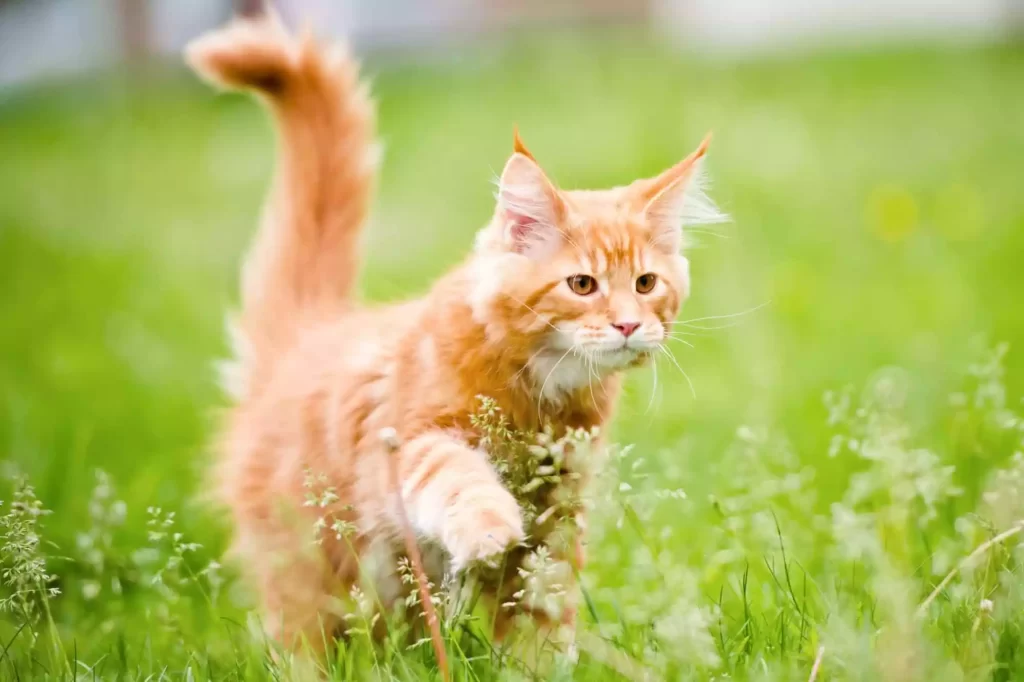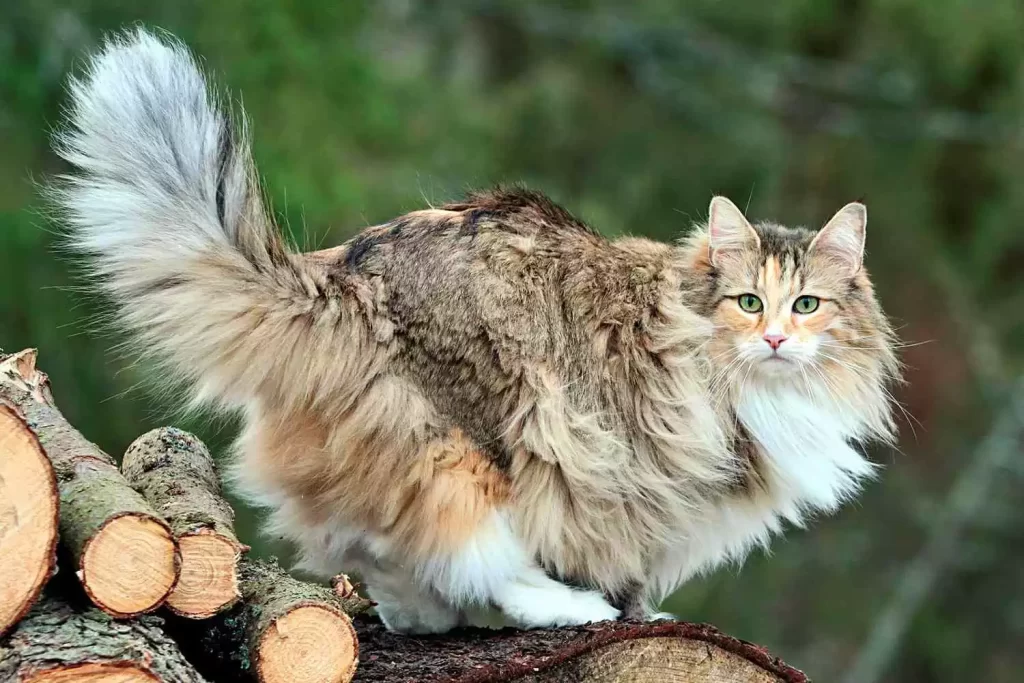What is Maine Coon Cat?
The Maine Coon cat is one of the largest and oldest domesticated cat breeds in the world.
- Origin: While the exact origin of the Maine Coon is uncertain, it is believed to have developed in the United States, particularly in the state of Maine. There are several folk legends and stories about its origin, including tales of it being a cross between domestic cats and raccoons, although these stories are not accurate.

- Physical Characteristics:
- Size: Maine Coon cats are known for their large size, with males typically weighing between 13 to 18 pounds (5.9 to 8.2 kg) and females between 8 to 12 pounds (3.6 to 5.4 kg).
- Coat: They have a distinctive, shaggy, and semi-longhaired coat that is water-repellent. Their fur can come in a variety of colors and patterns.
- Tail: Maine Coons have long, bushy tails that are wider at the base and taper to a point.
- Ears: They have large, tufted ears with lynx-like tips.
- Facial Features: Their faces are typically square-shaped, with a strong chin and expressive eyes.
- Personality and Temperament:
- Maine Coon cats are known for their friendly, sociable, and outgoing nature.
- They are often described as “gentle giants” because of their large size and gentle disposition.
- Maine Coons are highly intelligent and can be trained to perform tricks and follow commands.
- They are generally good with children and other pets, making them excellent family cats.
- Health:
- Maine Coon cats are susceptible to certain genetic health issues, including hypertrophic cardiomyopathy (a heart condition) and hip dysplasia.
- Regular veterinary check-ups and providing them with a healthy diet are crucial components to their well-being.
- Lifespan: Maine Coon cats typically have a relatively long lifespan, ranging from 12 to 15 years or even longer with proper care.
Maine Coon cats are known for their friendly and playful personalities, striking appearance, and adaptability to various living situations. They are a popular breed among cat enthusiasts and are often referred to as “gentle giants” because they combine size and gentle temperament.
What is a Norwegian Forest Cat?
The Norwegian Forest Cat, often referred to as the “Wedgie” (a colloquial term), is a distinctive and ancient breed known for its robust build and luxurious coat.
Here are some key characteristics and information about Norwegian Forest Cats:
- Origin: The Norwegian Forest Cat has its roots in Norway and is considered a natural breed that evolved over centuries in the Scandinavian wilderness. They are adapted to harsh, cold climates and are often associated with Norwegian folklore.

- Physical Characteristics:
- Size: Norwegian Forest Cats are a medium to large breed. Males typically weigh between 13 to 22 pounds (5.9 to 10 kg), and females range from 8 to 18 pounds (3.6 to 8.2 kg).
- Coat: They have a dense, semi-longhaired coat that serves as insulation against cold weather. Their fur is water-repellent and can come in various colors and patterns.
- Tail: They have a long, bushy tail that helps them balance in their natural forest habitat.
- Ears: Their ears are medium-sized with lynx-like tufts at the tips.
- Facial Features: Norwegian Forest Cats have triangular-shaped faces with expressive almond-shaped eyes.
- Personality and Temperament:
- Wedgies are known for their friendly and gentle nature.
- They are generally reserved with strangers but can be very affectionate and loyal to their human families.
- These cats are active, playful, and known for their love of climbing and exploring.
- They are intelligent and can be trained, although they may retain some independent traits.
- Health:
- Norwegian Forest Cats are generally healthy, but like all breeds, they can be prone to certain genetic health issues such as hip dysplasia and hypertrophic cardiomyopathy (a heart condition).
- Regular veterinary check-ups and a balanced diet are essential for their well-being.
- Lifespan: Norwegian Forest Cats have a relatively long lifespan, often living between 12 to 16 years or more with proper care.
Due to their natural adaptations and charming personalities, Norwegian Forest Cats make excellent companions for those who appreciate their unique traits and are willing to provide them with the care and attention they deserve.
Maine Coon and Norwegian Forest Cat in the comparison chart
Here’s a comparison chart summarizing the key differences and similarities between Maine Coon and Norwegian Forest Cats:
| Characteristic | Maine Coon | Norwegian Forest Cat |
|---|---|---|
| Origin | United States (Maine) | Norway |
| Size | Larger and heavier | Medium to large |
| Coat | Shaggy, semi-longhaired | Dense, semi-longhaired |
| Tail | Long and bushy | Long and bushy |
| Ears | Large with tufts | Medium-sized with tufts |
| Facial Features | Square-shaped face | Triangular face |
| Personality | Sociable, friendly, playful | Reserved, affectionate, playful |
| Intelligence | Highly intelligent | Intelligent |
| Trainability | Easily trainable | Can be trained |
| Compatibility | Good with children, other pets | Good with children, other pets |
| Health Issues | Genetic predispositions | Genetic predispositions |
| Lifespan | 12-15 years or longer | 12-16 years or longer |
Similarities
- Both have semi-longhaired coats.
- Both are intelligent and can be trained.
- Both enjoy climbing and exploring.
- Both can be playful and affectionate with their owners.
When choosing between these two breeds, consider your living situation, preferences in terms of size and temperament, and the grooming needs of each cat to make the best choice for your household.
Origin and history
Let’s delve deeper into the origin and history of the Maine Coon and Norwegian Forest Cat:
Maine Coon:
- Origin: The exact origin of the Maine Coon is a subject of folklore and speculation. One popular theory is that they are descendants of domestic cats brought to America by seafarers in the 19th century and then interbred with local cats in the state of Maine. However, this theory is largely unsubstantiated.
- History: Maine Coon cats are considered one of the oldest domesticated cat breeds in North America. They were well-established in the northeastern United States by the mid-1800s and were recognized as a breed in the late 1800s. Maine Coons were initially bred for their working abilities, particularly as skilled mousers on farms and ships.
Norwegian Forest Cat:
- Origin: The Norwegian Forest Cat, or “Skogkatt” as it’s known in Norway, is native to Norway and is believed to have a long history dating back over a thousand years. These cats are often associated with Norse mythology and legends.
- History: Norwegian Forest Cats are considered a natural breed, meaning they evolved in their native habitat without much human interference. They were well-suited to Norway’s cold and rugged terrain, where their thick, insulating fur and survival skills were highly valued. While they were initially considered working cats, they became cherished pets and were recognized as a breed in the mid-20th century.
The Maine Coon is believed to have originated in the United States, particularly in the state of Maine, and its history is intertwined with American folklore. On the other hand, the Norwegian Forest Cat has a deep-rooted history in Norway, where it evolved naturally in the country’s forests and mountains and played a significant role in Norwegian culture and mythology.
Choosing the Right Cat for You
Choosing the right cat for you is a crucial decision that involves considering various factors to ensure a harmonious and fulfilling relationship between you and your feline companion.
- Lifestyle and Living Space:
- Activity Level: Consider your activity level. Do you lead an active lifestyle with lots of playtime, or are you more of a homebody?
- Living Space: Think about your living space. Do you live in a small apartment or a spacious house with outdoor access?
- Time Commitment: Cats, like any pets, require time and attention. Ensure you have the time to care for and interact with your cat.
- Allergies:
- If you or any family members are prone to allergies, consider hypoallergenic cat breeds or consult with an allergist before bringing a cat into your home.
- Breed Traits:
- Research different cat breeds to find one that aligns with your preferences for size, coat type, temperament, and energy level. Remember, mixed-breed cats can also make wonderful companions.
- Age:
- Decide whether you want a kitten, adult, or senior cat. Kittens are playful but require more training, while adult cats often require less active attention.
- Grooming Needs:
- Some cats, like Maine Coons, have high grooming needs due to their long fur. Consider how much time you’re willing to spend on grooming or if you’d prefer a low-maintenance coat.
- Health Considerations:
- Be prepared for potential health issues. Research breed-specific health concerns and plan for regular veterinary care.
- Socialization:
- If you have other pets, ensure the new cat’s temperament aligns with your existing pets. Some cats are more social and adaptable than others.
- Adoption vs. Breeder:
- Decide if you want to adopt from a shelter or rescue organization or purchase from a reputable breeder. Adoption can provide a loving home to a cat in need, while breeders can provide specific breeds and health guarantees.
- Budget:
- Consider the financial aspect. Cats need food, litter, toys, and regular veterinary attention for optimal health. Ensure you can comfortably provide for your cat’s needs.
- Long-Term Commitment:
- Cats can live for 15 years or more. Make sure you’re ready for the long-term commitment and the emotional attachment that comes with it.
- Personality Match:
- Spend time interacting with cats to find one whose personality matches yours. Some cats are more independent, while others are highly affectionate and clingy.
- Responsible Ownership:
- Commit to responsible pet ownership, which includes spaying/neutering, providing proper nutrition, regular vet visits, and keeping your cat indoors or ensuring a safe outdoor environment.
The right cat for you should fit your lifestyle, preferences, and commitment level. Take the time to research, visit shelters or breeders, and interact with different cats to find the one that best suits your needs and will make a loving addition to your family.
Conclusion
Choosing the right cat involves considering your lifestyle, living space, allergies, breed traits, and more. It’s a long-term commitment, so take your time to find a cat whose personality and needs align with yours. Whether you adopt or buy, responsible ownership is key to a happy and healthy relationship with your feline friend.
